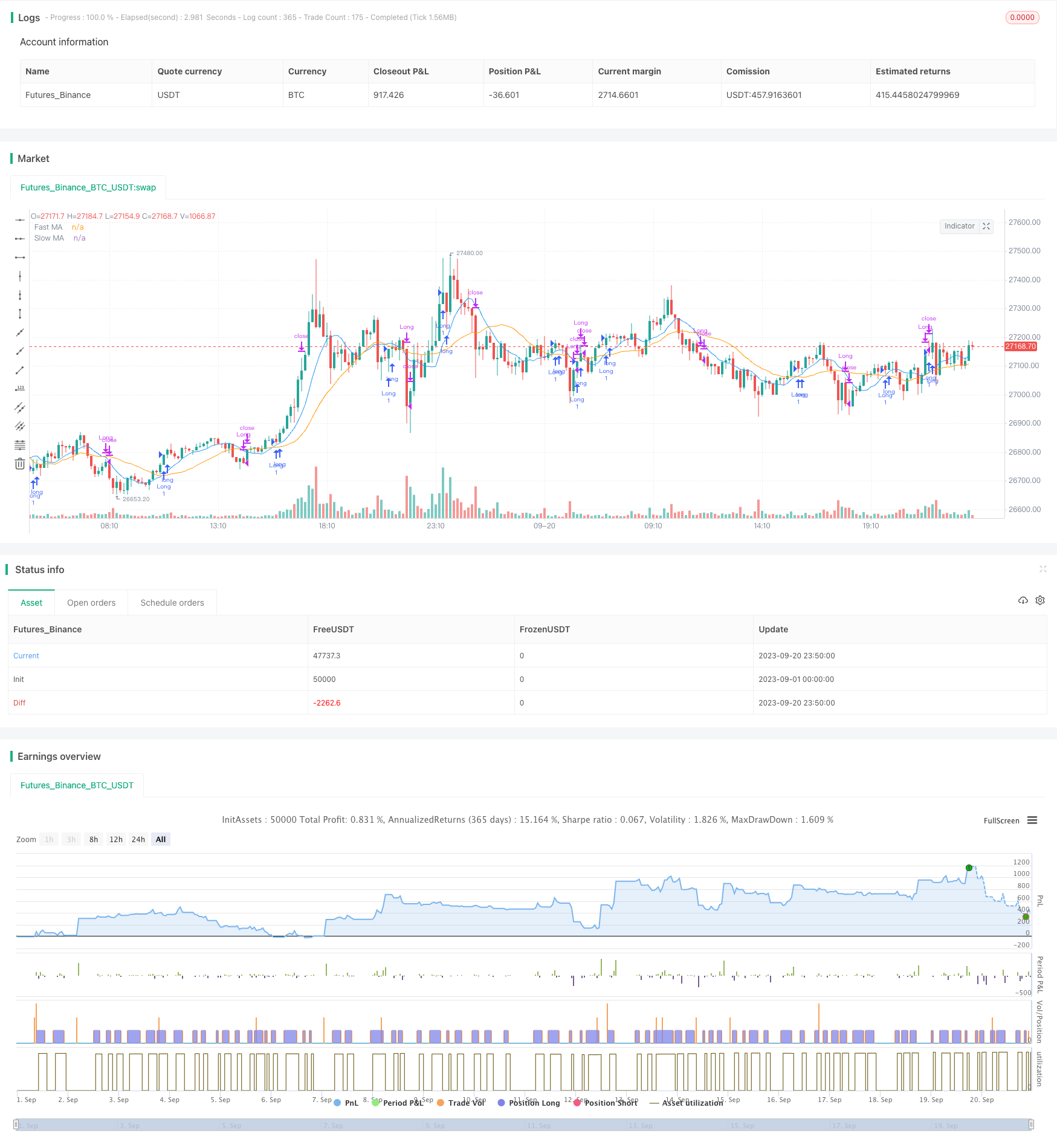
概述
该策略是一种基于移动均线的趋势跟踪策略。它利用快速移动均线和慢速移动均线的金叉和死叉来判断趋势方向,实现低风险的趋势跟踪交易。
策略原理
该策略使用了长度为9的快速移动均线和长度为21的慢速移动均线。当快速移动均线上穿慢速移动均线时,表示市场进入上升趋势,这时做多;当快速移动均线下穿慢速移动均线时,表示市场进入下降趋势,这时平仓做多头仓位。
具体来说,策略通过计算快速移动均线和慢速移动均线的值,并比较两者的大小关系来判断趋势方向。在多头方向时,如果快速移动均线上穿慢速移动均线,就会触发做多信号,进入长仓。在空头方向时,如果快速移动均线下穿慢速移动均线,就会触发平仓信号,平掉之前的多头仓位。
这样,通过快慢均线的金叉死叉来捕捉市场趋势的转换,实现低风险的趋势跟踪交易。
策略优势
- 使用移动均线判断趋势,可以过滤市场噪音,识别趋势方向
- 快速移动均线能更快捕捉趋势转换,慢速移动均线过滤假信号
- 采用金叉买入、死叉卖出的交易信号,避免追高杀跌
- 策略交易逻辑简单清晰,容易理解实现
策略风险
- 移动均线存在滞后,可能错过趋势转换的最佳时间点
- 固定平均线长度无法适应市场各种周期
- 双均线策略容易产生频繁交易信号,存在过拟合风险
- 仅使用均线判断易受突发事件影响,存在亏损风险
可以通过调整均线参数、引入其他指标作为过滤、设置止损止盈来管理风险。
策略优化方向
- 尝试不同的参数设置,如均线长度组合、金叉死叉判断标准等
- 增加量能指标等过滤器,避免假突破
- 增加趋势指标判断,区分趋势和震荡市场
- 结合波动率指标优化止损止盈设定
- 引入机器学习算法动态优化参数
总结
该策略作为一种简单的趋势跟踪策略,核心思想是通过快速和慢速均线组合判定趋势方向。优点是简单易懂,交易规则清晰,能够有效跟踪趋势;缺点是存在滞后且容易产生假信号。我们可以通过调整参数以及加入其他技术指标来优化该策略,使其更好地适应市场环境。总的来说,双均线策略作为一种基础策略,为量化交易提供了一个简单可靠的思路。通 过不断优化和改进,可以使这一策略的实际交易效果更佳。
策略源码
/*backtest
start: 2023-09-01 00:00:00
end: 2023-09-20 23:59:59
period: 10m
basePeriod: 1m
exchanges: [{"eid":"Futures_Binance","currency":"BTC_USDT"}]
*/
//@version=5
strategy("Profitable Crypto Strategy", shorttitle="Profit Strategy", overlay=true)
// Define strategy parameters
fastLength = input.int(9, title="Fast MA Length", minval=1)
slowLength = input.int(21, title="Slow MA Length", minval=1)
stopLossPercent = input.float(1.0, title="Stop Loss %", step=0.1)
takeProfitPercent = input.float(1.0, title="Take Profit %", step=0.1)
// Calculate moving averages
fastMA = ta.sma(close, fastLength)
slowMA = ta.sma(close, slowLength)
// Entry condition: Buy when fast MA crosses above slow MA
longCondition = ta.crossover(fastMA, slowMA)
// Exit condition: Sell when fast MA crosses below slow MA
shortCondition = ta.crossunder(fastMA, slowMA)
// Plot moving averages on the chart
plot(fastMA, color=color.blue, title="Fast MA")
plot(slowMA, color=color.orange, title="Slow MA")
// Strategy entry and exit logic
var stopLossPrice = 0.0
var takeProfitPrice = 0.0
if (longCondition)
stopLossPrice := close * (1.0 - stopLossPercent / 100)
takeProfitPrice := close * (1.0 + takeProfitPercent / 100)
strategy.entry("Long", strategy.long)
if (shortCondition)
strategy.close("Long")
// Set stop loss and take profit for open positions
strategy.exit("Stop Loss/Profit", stop=stopLossPrice, limit=takeProfitPrice)